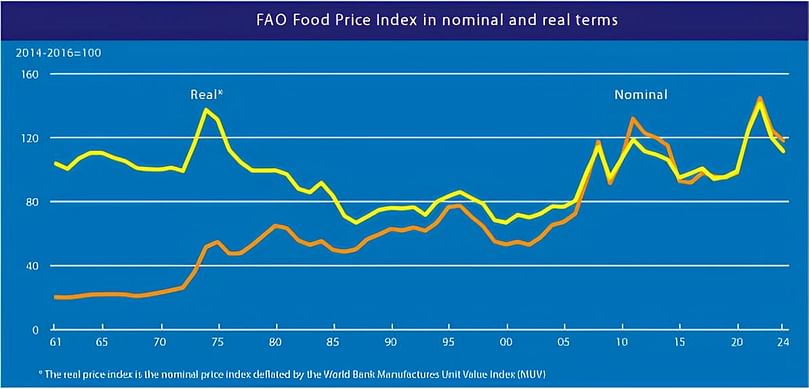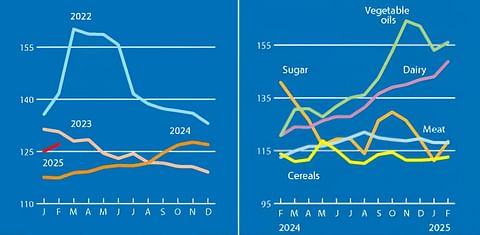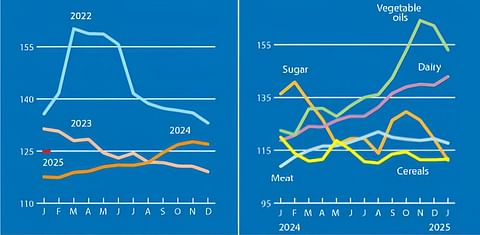FAO Food Price Index up marginally in April, mostly driven by higher world meat prices
FAO Food Price Index up marginally in April, mostly driven by higher world meat prices

The FAO Food Price Index* (FFPI) stood at 119.1 points in April 2024, up 0.3 points (0.3 percent) from its revised March level, as an increase in the price index for meat and smaller upturns of vegetable oil and cereal indices slightly more than offset decreases in those for sugar and dairy products. Although it registered a second monthly uptick in April following a seven-month long declining trend, the FFPI was down 9.6 points (7.4 percent) from its corresponding value one year ago.
The FAO Cereal Price Index averaged 111.2 points in April, up 0.3 points (0.3 percent) from March but 25 points (18.3 percent) below its April 2023 value. After declining for three consecutive months, average global wheat export prices stabilized in April. Upward price pressure stemming from concerns about unfavourable crop conditions impacting 2024 harvests in parts of the European Union, the Russian Federation and the United States of America was countered by continuing strong competition among major exporters.
By contrast, maize export prices increased in April, mainly influenced by high import demand amidst mounting logistical disruptions as a result of infrastructure damages in Ukraine and reduced production prospects in Brazil ahead of the start of the main harvest. For other coarse grains, world prices of barley also rose while those of sorghum declined in April. The FAO All Rice Price Index declined by 1.8 percent, largely due to falls in Indica quotations driven by harvest pressure.
The FAO Vegetable Oil Price Index averaged 130.9 points, up 0.3 points (0.3 percent) month-on-month and marking a 13-month high. The marginal increase reflects the net effect of higher sunflower and rapeseed oil quotations, more than offsetting slightly lower palm and soyoil prices.
International palm oil prices trended lower in April, largely influenced by seasonally higher outputs in leading producing countries and lingering subdued global import demand. Meanwhile, world soyoil prices declined after a short-lived recovery, -reflecting prospects of ample supplies from South America following favourable soybean production outlook. By contrast, international sunflower and rapeseed oil prices kept rising, underpinned by, respectively, continued firm global import purchases and concerns over unfavourable weather conditions for winter rapeseed in parts of Europe.
The FAO Dairy Price Index averaged 123.7 points in April, down marginally (0.3 points and 0.3 percent) from March, marking a downturn after six months of continuous increases, but remained 5.5 points (4.3 percent) below its value in the corresponding month last year. International prices of skim milk powder declined the most, primarily underpinned by sluggish import demand for spot supplies amid high exportable availabilities, especially in Western Europe.
Meanwhile, world cheese prices fell slightly, mainly reflecting the strengthening of the United States dollar. By contrast, world butter prices continued to increase due to steady import demand and somewhat tighter butter inventories in Western Europe. In the meantime, whole milk powder prices rebounded moderately due to increased demand for medium-term supplies and seasonally declining milk production in Oceania.
The FAO Meat Price Index* averaged 116.3 points in April, up 1.9 points (1.6 percent) from March, marking the third consecutive monthly increase and making the index stand only marginally (0.4 percent) below its corresponding value one year ago.
In April, international poultry meat prices rose, underpinned by steady import purchases by Middle East countries amid the continued challenges to production stemming from avian influenza outbreaks. World bovine meat prices also increased, driven by the continued high demand from major importers, notwithstanding increased supplies from domestic sources in leading importing countries.
Ovine meat prices bounced back slightly on market expectations for supplies to seasonally tighten in Oceania. By contrast, world pig meat prices fell marginally, reflecting slack internal demand in Western Europe and persistently lacklustre demand from leading importers, especially China.
The FAO Sugar Price Index averaged 127.5 points in April, down 5.9 points (4.4 percent) from March, marking a second consecutive monthly decline and standing 21.9 points (14.7 percent) below its value in April 2023. The decrease in world sugar prices was mostly related to improved global supply prospects, notably due to larger-than-previously-anticipated outputs in India and Thailand.
In addition, improved rainfall in Brazil in late March and early April, after a prolonged period of dry weather conditions, eased concerns over prospects for the recently started harvest and contributed to the month-on-month price decline. The weakening of the Brazilian real against the United States dollar also contributed to lowering sugar prices in April. By contrast, higher international crude oil prices and ethanol prices in Brazil contained the decrease in world sugar prices.

FAO Food Price Index in nominal and real terms










